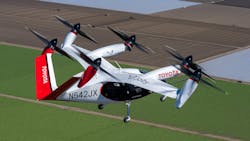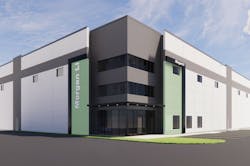So That Happened: Helene Hits IV Fluids and Air Taxis Hail Investment
Editor’s note: Welcome to So That Happened, our editors’ takes on things going on in the manufacturing world that deserve some extra attention. This will appear regularly in the Member’s Only section of the site.
IV Fluids Take a Hit from Helene
One manufacturer battered by Hurricane Helene in western North Carolina is a Baxter International plant that is among the largest producers of IV fluids for hospitals in the United States. But patients may not notice a shortage as healthcare providers, government officials, other manufacturers and Baxter itself are collaborating to fill the gap in sterile water, and saline, carbohydrate and other fluids that are ubiquitous and essential in healthcare settings.
The plant in North Cove, North Carolina, suffered flooding after a levee breach that cause water damage to inventory and raw materials. A damaged bridge and roadway collapse caused limited access to the facility.
Keeping more than a week to 10 days’ of inventory of IV fluids on hand is impractical for hospitals because the bags are heavy and bulky, a representative from the American Society of Health System Pharmacists told NPR.
Some hospitals are discussing limiting elective surgeries, while the FDA may temporarily allow imported IV fluids. Meanwhile, Baxter competitor Fresenius, a German-based company, is considering hastening the launch of new production lines at its plant in North Carolina.
In an Oct. 9 letter to customers, Baxter said its goal is to have North Cove production back to 90% to 100% by the end of 2024.
—Laura Putre
Morgan Li: Back and Better Than Before
If you’re a frequent IW reader, you may remember the story of custom fabrication company Morgan Li. After a devastating fire destroyed 230,000 square feet of finished-goods warehouse space, the company optimized key supply chain strategies to successfully rebuild, and it recently took the next big step on its path to recovery.
Morgan Li recently broke ground on a 240,000 square-foot facility in Chicago Heights, the same community where the company lost its warehouse space in 2023. The building will feature over 20 loading docks and consolidate all manufacturing and warehousing operations under one roof. In addition, a separate 40,000 square-foot painting building will handle finished products.
“This facility is more than just a building. It represents Morgan Li’s dedication to growth, innovation and our deeply rooted ties to Chicago Heights,” says Morgan Li President Jonathan Rosenband. “The decision to rebuild on the same site rather than relocate, and our list of local partners helping to make this project a reality, reflects the company’s commitment to the community.”
Adding to the already impressive recovery efforts of the company, the new facility will reduce its carbon footprint and waste by being energy efficient, having metal and cardboard recycling capabilities and featuring a dedicated paint line for refurbishment.
The new facility is slated to open in the spring of 2025.
—Anna Smith
Air Taxis Continue to Hail Big Investments
The numbers keep getting bigger in the emerging air taxi space—and the timelines are getting very short.
The latest big headline in the development of electric vertical take-off and landing aircraft, or eVTOLs, came last week from Toyota Motor Corp. The company’s leaders said they will invest $550 million in California-based Joby Aviation Inc. as the latter moves toward regulatory certification of its products and eyes the start of operations next year in, among other places, New York and Los Angeles. (In the Big Apple, the company is touting that its service will get people from the heart of Manhattan to John F. Kennedy Airport in just seven minutes.)
Toyota has been putting money, time and expertise into Joby for seven years, at first through its venture capital arm. Its latest commitment—which will be put to work in two phases—lifts the company’s total investment to $894 million. The goal: to help “realize the dream of air mobility for personal or daily travel as part of [Toyota’s] transformation into a mobility company.”
An interesting sidenote to Toyota’s investment is that it further solidifies the company’s direct competition in the eVTOL space with automotive rival Stellantis NV. (Boeing Co. also is in this game, having acquired Wisk Aero last year on the heels of first making a $450 million investment.) Stellantis executives have over the years invested nearly $300 million in another California-based air taxi venture, Archer Aviation Inc., and in August said they will fund up to $370 million of manufacturing labor costs (in return for more equity) to help Archer grow its capacity up to 650 aircraft per year.
—Geert De Lombaerde
Robot Slowdowns and Ongoing IT/OT Divides
The Association for Advancing Automation (A3) released Tuesday its newest robotics industry statistics. Robot orders are down 7.9% and revenue is down 6.8% in the first half of 2024 compared to the same period last year. A3 blames “ongoing economic headwinds faced by North American manufacturers.”
The semiconductors and electronics/photonics sector recorded the largest decreases with 40% fewer robot orders and a 41.4% decrease in revenue.
The automotive components sector also recorded decreases, with 38.8% fewer orders and 27.3% decline in revenue. Automotive OEMs ordered 14.4% more robot units in the first half of 2024 compared to last year, but revenues still decreased by 12%.
On the other hand, robot orders and revenues increased by 85.6% and 56.2% respectively in the food and consumer goods sector and by 47.9% and 86.7% respectively in the life sciences sector.
Another pair of reports from the past few weeks taken together offers a depressing conclusion. Siemens and the Manufacturers Alliance Foundation on September 24 released a report on legacy systems and digital transformation, presenting manufacturers’ top five concerns about technology upgrades:
- Budget constraints
- Security concerns
- Limited skilled workforce for emerging technologies
- Compatibility issues between old and new tech
- The complexity of integrating diverse technologies
Part of the solution to all these problems is solving the IT/OT divide – getting both teams on the same page. We hear about this conflict often – in our last So That Happened I cited an ABI Research survey that stated only 39% of respondents felt their IT and OT teams collaborated effectively.
On Thursday, Oct. 3, I received a report from TeamViewer, a remote connectivity and digitalization provider, that also addressed the IT/OT divide. Less than half of respondents said the departments connected effectively, and only “some or to a minimal extent” when they cooperated at all.
In other words, the two departments that have to be on the same page to address modernizing manufacturing plants still can’t learn out how to work together. Now taking bets on how long it will take someone to figure out the solution. Whoever comes up with the answer will be a rock star on the conference circuit.
— Dennis Scimeca
About the Author
Geert De Lombaerde
Senior Editor
A native of Belgium, Geert De Lombaerde has been in business journalism since the mid-1990s and writes about public companies, markets and economic trends for Endeavor Business Media publications, focusing on IndustryWeek, FleetOwner, Oil & Gas Journal, T&D World and Healthcare Innovation. He also curates the twice-monthly Market Moves Strategy newsletter that showcases Endeavor stories on strategy, leadership and investment and contributes to other Market Moves newsletters.
With a degree in journalism from the University of Missouri, he began his reporting career at the Business Courier in Cincinnati in 1997, initially covering retail and the courts before shifting to banking, insurance and investing. He later was managing editor and editor of the Nashville Business Journal before being named editor of the Nashville Post in early 2008. He led a team that helped grow the Post's online traffic more than fivefold before joining Endeavor in September 2021.
Anna Smith
News Editor
News Editor
LinkedIn: https://www.linkedin.com/in/anna-m-smith/
Bio: Anna Smith joined IndustryWeek in 2021. She handles IW’s daily newsletters and breaking news of interest to the manufacturing industry. Anna was previously an editorial assistant at New Equipment Digest, Material Handling & Logistics and other publications.

Laura Putre
Senior Editor, IndustryWeek
As senior editor, Laura Putre works with IndustryWeek's editorial contributors and reports on leadership and the automotive industry as they relate to manufacturing. She joined IndustryWeek in 2015 as a staff writer covering workforce issues.
Prior to IndustryWeek, Laura reported on the healthcare industry and covered local news. She was the editor of the Chicago Journal and a staff writer for Cleveland Scene. Her national bylines include The Guardian, Slate, Pacific-Standard and The Root.
Laura was a National Press Foundation fellow in 2022.
Got a story idea? Reach out to Laura at [email protected]
Dennis Scimeca
Dennis Scimeca is a veteran technology journalist with particular experience in vision system technology, machine learning/artificial intelligence, and augmented/mixed/virtual reality (XR), with bylines in consumer, developer, and B2B outlets.
At IndustryWeek, he covers the competitive advantages gained by manufacturers that deploy proven technologies. If you would like to share your story with IndustryWeek, please contact Dennis at [email protected].



